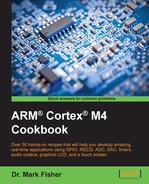As sampling frequency plays such a critical role in determining the quality of the digital representation of the analog signal input, and to avoid aliasing artifacts, it is preferable to use a timer to trigger the conversion rather than to enable continuous conversions as we did in the previous recipe. This recipe, adcTimerISR_c5v0, illustrates this technique. The aim of this recipe is to configure TIM2 _CH2 in output compare mode so that it toggles every 100 ms and then use this timing signal to trigger the ADC.
- First create a new project called
adcTimerISR.uvprojxand use the RTE manager to configure it as we did for the folderadcISR_c5v0for the Setting up the ADC recipe. - Copy
timer.candCustom_ADC.cfrom the previous recipes and add these to the project. CopyadcISR.cand rename itadcTimerISR.c. Add this to the project. - Add
#include timer.htoadcTimerISR.cand callTIM2_Initialize()inmain(). Check whether the project successfully builds. - Modify the
TIM2_Initialize()function so that it no longer produces an update interrupt flag (UIF) by deleting the following statements:TIM2->DIER = (1UL << 0); NVIC_EnableIRQ(TIM2_IRQn); - Configure
TIM2_CH2to toggle channel 2 capture/compare output by writing to the appropriate fields of Capture/Compare Mode Register 1 (CCMR1) and Capture/Compare Enable Register (CCER):TIM2->CCMR1 |= ( 3UL << 12 ); TIM2->CCER |= ( 1UL << 4 );/*************************************************** * TIM2_Initialize ( ) *************************************************** * Initializes TIM2 * Capture Compare 2 Interrupt Flag (CC2IF) * generates interrupts every 100ms (0.1s) * SystemCoreClock = 168 MHz - set by SystemInit ( ) * Refer to Figure 134 of STM Reference Manual * TIMxCLK = SystemCoreClock/2 * Hence ticks = 0.1 * 168,000,000 / 2 = 8,400,000 * Prescaler = 8400-1; ARR = 1000-1; * Note: Capture Compare Register is left in Reset ***************************************************/ void TIM2_Initialize (void) { const uint16_t PSC_val = 8400; const uint16_t ARR_val = 1000; /* En. clk for TIM2 */ RCC->APB1ENR |= RCC_APB1ENR_TIM2EN; TIM2->PSC = PSC_val - 1; /* set prescaler */ TIM2->ARR = ARR_val - 1; /* set auto-reload */ TIM2->CR1 = ( 1UL << 0 ); /* set Ctr. En. (CEN) */ TIM2->CCMR1 |= ( 3UL << 12 ); /* OC1REF toggles when TIMx_CNT=TIMx_CCR1*/ TIM2->CCER |= ( 1UL << 4 ); /* CC2E set */ } - Modify the
adc_Initialize_and_Set_IRQ ( )function to trigger conversions on both the rising and falling edge ofTIM2_CH2by writing to Control Register 2:ADC3->CR2 |= ( 3UL << 28); ADC3->CR2 |= ( 3UL << 24); - Remember to run the ADC in single conversion mode:
void ADC_Initialize_and_Set_IRQ (void) { /* Setup potentiometer pin PF9 (ADC3_7) and ADC3 */ RCC->APB2ENR |= (1UL << 10); /* En. ADC3 clk */ RCC->AHB1ENR |= (1UL << 5); /* En. GPIOF clk */ GPIOF->MODER |= (3UL << 2*9);/* PF9 = Analog mode */ ADC3->SQR1 = 0; ADC3->SQR2 = 0; ADC3->SQR3 = (7UL << 0); /* SQ1 = chan. 7 */ ADC3->SMPR1 = 0; /* Chan. 7 sample */ ADC3->SMPR2 = (7UL << 18); /* time = 480 cyc. */ ADC3->CR1 = (1UL << 8); /* Scan mode on */ ADC3->CR1 |= ( 1UL << 5); /* En. EOC IRQ */ ADC3->CR2 |= ( 3UL << 28); /* Trig on both edg */ ADC3->CR2 |= ( 3UL << 24); /* of TIM2_CC2 */ ADC3->CR2 |= ( 1UL << 0); /* ADC enable */ NVIC_EnableIRQ( ADC_IRQn ); /* Enable IRQ */ ADC3->CR2 |= (1 << 30); /* Start 1st conversion */ } - Build, download, and run the program. You will notice that, when we execute this program, the output appears much more stable than it did using a continuous mode. This is just a consequence of performing fewer conversions, but it does serve to emphasize the need to avoid oversampling unless there is good reason.
In addition to the update event interrupt, each timer also allows interrupts to be generated by up to four capture compare channels (TIMx_CH1-TIMx_CH4). Each Capture/Compare channel comprises a Capture/Compare register, an input stage for capture (with digital filter, multiplexing, and prescaler), and an output stage (with comparator and output control). Each can be configured as the input capture, PWM input, forced output, output compare, PWM, or one-pulse modes. The output compare mode can be used to provide timing signals that can be used to start A-D conversions.
One of 16 possible start conversion triggers can be selected for the regular group of channels by writing to the ADC control register 2 (ADC_CR2) bit field, EXTSEL[3:0]. The following table shows how the trigger sources are encoded
Note
CH1-CH4 and TRGO refer to timer channels. For further information, refer to STM's RM0090 Reference manual (http://www.st.com), Chapters 17 and 18.
|
EXTSEL[3:0] |
Start Trigger |
EXTSEL[3:0] |
Start Trigger |
|---|---|---|---|
|
0000 |
TIM1_CH1 |
1000 |
TIM3_TRGO |
|
0001 |
TIM1_CH2 |
1001 |
TIM4_CH4 |
|
0010 |
TIM1_CH3 |
1010 |
TIM5_CH1 |
|
0011 |
TIM2_CH2 |
1011 |
TIM5_CH2 |
|
0100 |
TIM2_CH3 |
1100 |
TIM5_CH3 |
|
0101 |
TIM2_CH4 |
1101 |
TIM8_CH1 |
|
0110 |
TIM2_TRGO |
1110 |
TIM8_TRGO |
|
0111 |
TIM3_CH1 |
1111 |
EXT11 |
The polarity of the trigger is determined by EXTEN, as shown in the following table:
|
EXTEN |
Trigger Polarity |
|---|---|
|
00 |
Trigger detection disabled |
|
01 |
Trigger detection on the rising edge |
|
10 |
Trigger detection on the falling edge |
|
11 |
Trigger detection on both the rising and falling edges |
